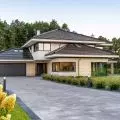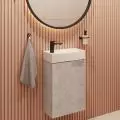An antidote to terraced field housing! Not from the shape of a field, but from the form of an ancient village takes its name and layout of a residential project by the Insomia studio. The intimate development of terraced houses will be called Wielodrożnica. It is thoughtfully designed to lead a dialogue with the history of the now-defunct Ławica manor in Poznań.
Terraced housing in Poland is becoming fatefully associated: with strips of segments stretching to the horizon along an internal road with a single connection to a public street. Such dehumanized "doe buildings" stand on de-landed narrow fields and take their name and absurd shape from them. However, terraced layouts can be shaped in interesting ways. This is often demonstrated by historical and, sometimes, contemporary projects, such as the latest concept by Insomia studio architects. The designers took on the „terraced house” on a larger scale for the second time, after the success of the award-winning and very successful Nowy Strzeszyn estate in Poznań.
they were captivated by the definition
The latest proposal is an intimate development in the western part of Poznań, in the former village of Ławica, at Witnicka and Ławica Streets, on the site of a former grange adjacent to a preserved manor park and green areas along the Junikowski Stream (investor: VOX Activ). Virtually nothing remains of the former buildings (in the early 1980s, the manor house standing outside the project boundary was also demolished).
Wielodrożnica, Poznań, the situation within the boundaries of Ławica—1. pre-war map with the marked buildings of the manor and farmstead; 2. the area of the investment on a contemporary photo; top (north): Ławica Airport
© Insomia
However, the history of the site served as the basis for the architects' new design. They „dug” into this history while looking for a framework and inspiration for their concept. They did not find them in the natural conditions, as was the case in Nowy Strzeszyn (the buildings there were subordinated to the dense growth of trees).
Thus, the starting points became the layout of the former farmstead and, to some extent, the village.
The village of Shoal was an example of a „multipath” type village. The definition captivated us. It was all we needed," reports Szymon Januszewski, head of Insomia, about the search for context, and cites the definition: "Multipath—a type of village with compact development along several, usually winding traffic routes (streets)."
And, indeed, the project refers in spirit to this type of development. It is quite dense, and the fifteen sets of houses (twelve four-segment rows and three "twins") are composed in such a way that the layout can be considered fairly free. The architects add:
"with the rather 'tight' provisions of the local plan, we were able to find a way to create an additional thoroughfare running through the center of the site, which allowed us to create an intimate layout of compact buildings along traffic systems allowing us to create interesting common spaces".
Wielodrożnica, Poznań, plan of the site—in orange marked buildings and spaces on the footprint of the former farm buildings. Under the main traffic route (on the north-south axis), a route serving underground garages runs underground (entrances from the south and north are marked).
© Insomia
reading the manor
And how does the project relate to the former farmstead buildings? Here the key is the material used.
All buildings within the contours of the former buildings will be made of ceramic materials from which the former manor buildings were made. This will also apply to the flooring and all permanent development elements. It will not be a literal recreation of the former buildings, but with a little willingness it will be possible to decipher their former layout. For example, there will be a building that only partially stands on the former outline of the development, which consequently leads to a division of the materials used on its facade.
Wielodrożnica, residential settlement, Poznań, visualization, part in the outline of the former farm buildings proj.: Insomia
© Insomia (visualization: GID Studio)
Thus, there will be a clear contrast between the brick forms „describing” the shape of the former buildings and the remaining buildings clad in light plaster or wood. The designers also announce that they intend to incorporate bricks from the foundations of the manor farm, discovered during preparations, into the public spaces of the settlement.
Multipath, residential development, Poznań, visualization, contrast of zones (post-farmstead part in the middle). Resembling an old chimney, the form is a ventilation shaft for underground garages. It is intended to be a kind of dominant enriched with additional elements (in development) proj.: Insomia
© Insomia (visualization: GID Studio)
Not only will the form of the facade and layout of the premise be differentiated, but also the size and appearance of the individual segments. The estate, or rather the settlement—as the designers themselves call it—is to consist of 58 small houses with areas ranging from 70 to 115 sqm. (most in the range between 80 and 90 sq. m.). As always with Insomia's designs, attention is drawn to the efficient and thoughtful layout of the rooms. All segments are designed as single-story with a usable attic. The designers report that:
thevery human-scale development is [...] due to the provisions of the local plan, in which the roof cornice was limited to a height of four meters.
Wielodrożnica, residential development, Poznań, visualization, proj.: Insomia
© Insomia (visualization: GID Studio)
with an idea, but by the airport
On each building there will be a photovoltaic installation integrated into the steep roof, a heat pump supply is planned, and rainwater retention is planned. Some of the houses will be equipped with underground garages, so that vehicular traffic will take place only around the perimeter of the entire quarter, and the traffic routes within it are to serve pedestrians only.
It is hoped that the space of the „village” designed in this way will create many opportunities to build neighborhood ties through communal spaces.
Staying in these spaces can also be fostered by saturating the area with greenery, which is to consist of both existing trees inventoried by Insomia (mainly in the northwestern part), as well as new specimens and freely composed low vegetation. Greenery is also to appear on facades and roofs. On the other hand, the noisy neighborhood of the Ławica Airport may prove to be a nuisance (not only on the outside!).
Wielodrożnica, residential development, Poznań, visualization, proj.: Insomia
© Insomia (visualization: GID Studio)
Nonetheless, it promises to be an interesting residential complex (there is already a building permit, work should start soon), which fits in with the idea Insomia has been pursuing for several years of creating dense, but intimate and well-thought-out housing estates (the investment we have described on Murawa 2 Street in Poznań is currently under construction in this spirit). By the way, the presented project contrasts positively with the investment recently completed by the same (!) owner on the northern side of the park, closer to Bukowska Street. It is also dense there, but the scaled-down multifamily „villas” standing in a barracks-like order are a completely different quality of thinking about space.
The reference to the old village seems much more appropriate, especially since the idyllic genius loci holds strong in this place. For although Ławica and other villages near Poznań were incorporated into the city by the Germans in 1940, it—like other areas absorbed at that time—has largely retained its original character. After the war, the Poles did not strongly urbanize these areas. More: they located some large-scale investments not within them, but in yet other areas—annexed to the city only in the 1970s and 1980s (the former villages of Piątkowo and Morasko).










































